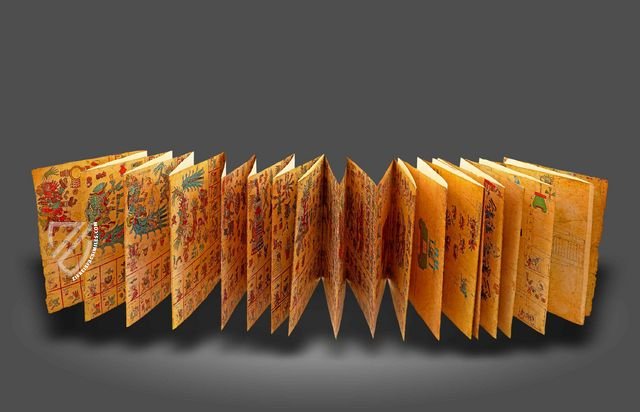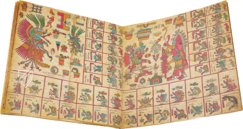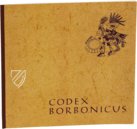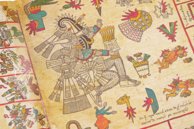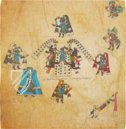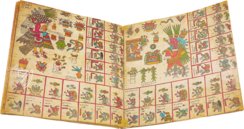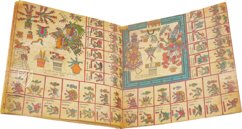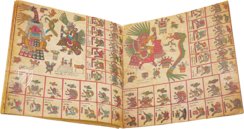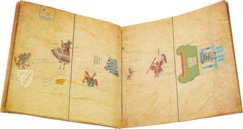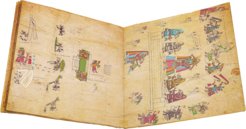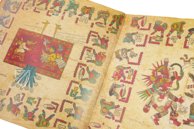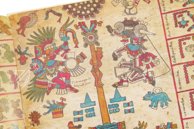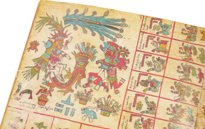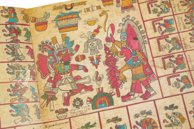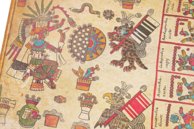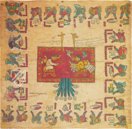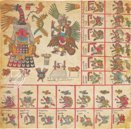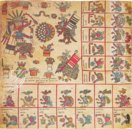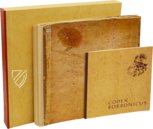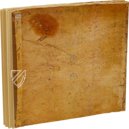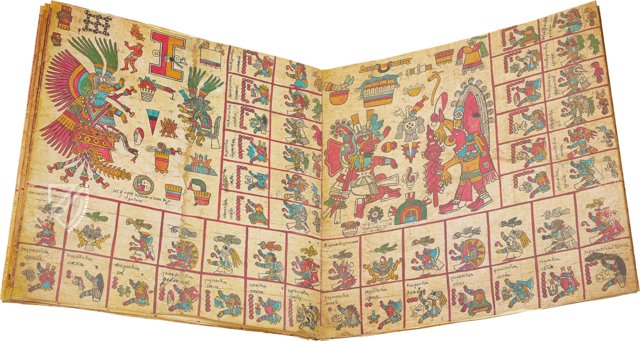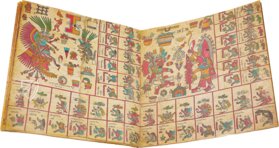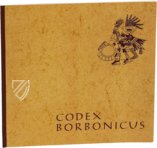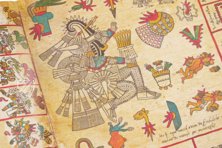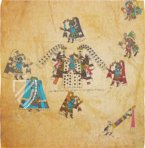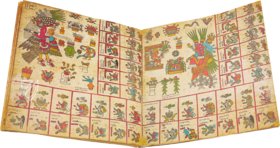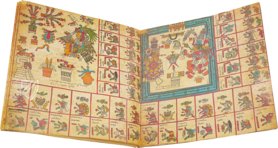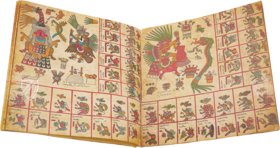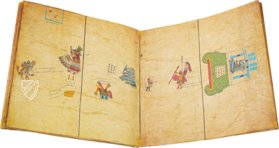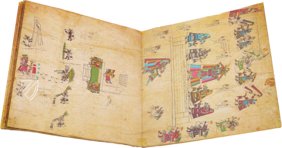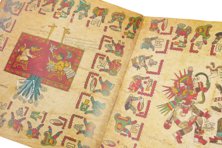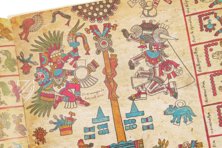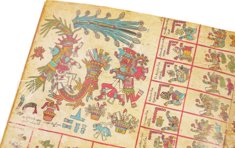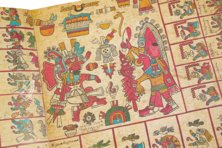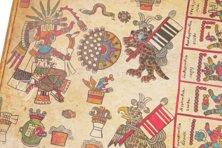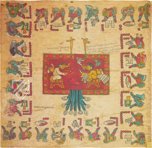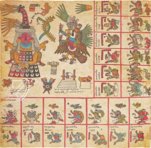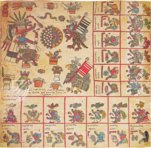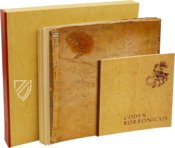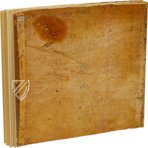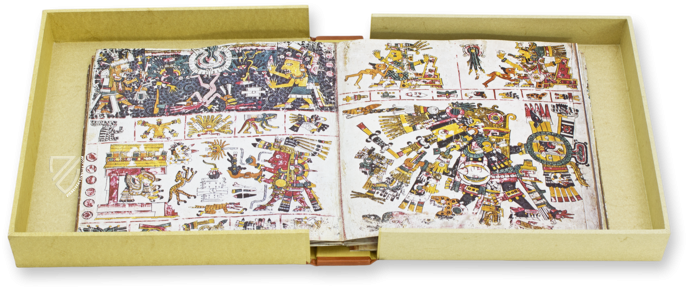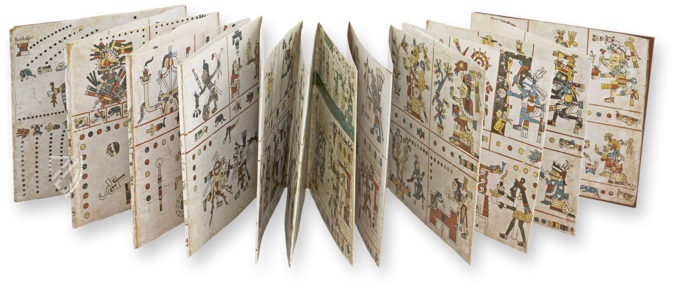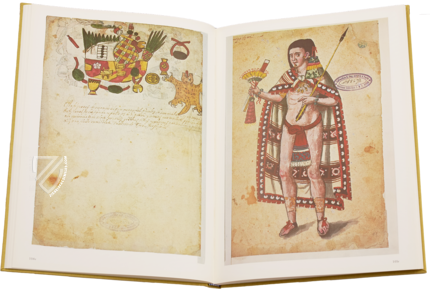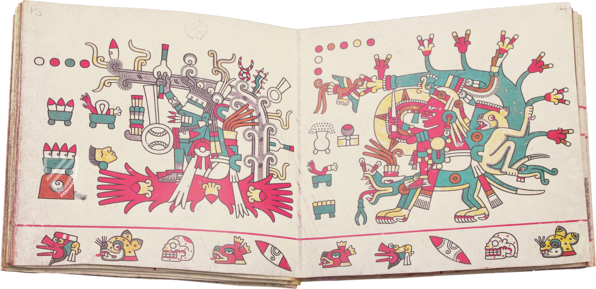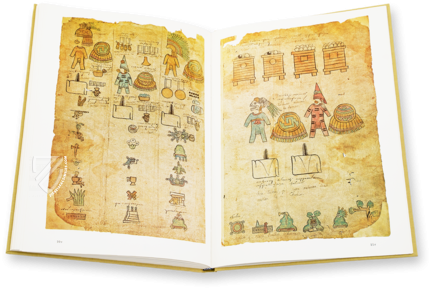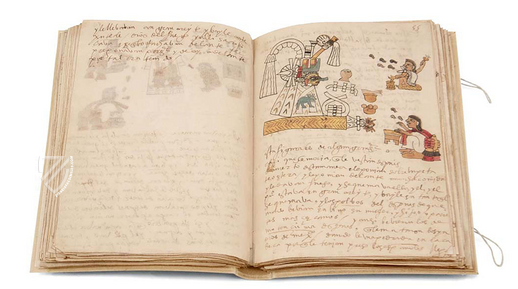Codex Borbonicus
(1,000€ - 3,000€)
One of the most interesting documents about pre-Hispanic Mexico from the 16th century: since few original Aztec documents survived the Spanish conquest of Mexico beginning in 1519, the Codex Borbonicus is invaluable. It represents an exceptionally rare Aztec priestly manuscript that is still completely free of European influence. Fascinating pictograms tell of the language, religion, and culture of Mexico when delved into; an Aztec divination calendar bears witness to the mystical side of this advanced civilization that to be destroyed by the Europeans so soon thereafter. Finally, some parts remain incomprehensible so far and are just waiting to be explored and deciphered. The value of the codex for Mexican studies is underlined once again by the fact that it comes from the immediate vicinity of the Aztec capital Tenochtitlán.
Codex Borbonicus
The Codex Borbonicus is a copy of a pre-Spanish illuminated manuscript from the early colonial age, which is now lost today. Therefore, this copy represents the only surviving specimen of this invaluable source on pre-Spanish Mexico and belong among a very small number of Aztec codices to survive the Spanish Inquisition in colonial New Spain. The value of the codex as a source of information about the Mexican language is emphasized by the fact that it serves not only as an illuminated manuscript for calendar information, but also as a work that with certainty originated from the strong influence of the Aztec capital, almost devoid of any European influence. This manuscript is critical for the analysis of Mexica calendric constructions, deities, and rituals. Its name is derived from its former repository in the Palais Bourbon in France but is stored today in the Bibliothèque de l'Assemblée Nationale in Paris.
An Aztec Unicum
The Codex Borbonicus is one of the most interesting documents about pre-Hispanic Mexico from the 16th century. This large format illuminated manuscript brings a lot of news that has not been preserved anywhere else. The fact that it also poses riddles that have not yet been solved makes it even more interesting.
The style of the illuminated manuscript is that of the high valley of Mexico at the time before the conquest by the Spaniards. The decoration of the Aztec manuscripts of this late period must have been immensely sumptuous. To assess this style, one must rely on copies from the colonial period because no original has been preserved in this region, which was exposed above all others. The Codex Borbonicus is a copy of a pre-Hispanic illuminated manuscript from the early colonial period.
The value of the codex as a source of Mexican studies is underlined by the fact that it is the only illuminated manuscript of calendrical content almost untouched by European influences and that it certainly originates from the closer sphere of influence of the Aztec capital.
History of the Manuscript
In their impatience to convert the peoples of Mexico to Christianity and “Europeanize” them, Spanish Inquisitors destroyed entire libraries full of thousands of indigenous manuscripts, which must be one of the great cultural atrocities in history and represents a tremendous and irrevocable loss of knowledge. The Codex Borbonicus was one of the few manuscripts to be spared from this fate, but when and under what circumstances it came to Europe are not known. It was first mentioned in the El Escorial Library in 1778 but appears to have been stolen sometime during the first quarter of the 19th century. It reappeared at a French auction in 1826 and was acquired by Pierre-Paul Druon, curator of the library of the National Assembly for 1,300 gold francs. The Codex Borbonicus was officially designated as a National Treasure of France in 1960. Two facsimiles of the original have been made, a color lithograph of a handmade copy from 1899 and this high-quality photographic reproduction created in 1974.
Codicology
- Size / Format
- 38 colored pages in leporello folding / 39.0 × 40.0 cm
- Origin
- Mexico
- Date
- 16th century
- Epochs
- Style
- Language
- Script
- Cursive
- Illustrations
- 36 miniatures
- Content
- Ritual ceremonies and divination calendar of the Aztecs
- Previous Owners
- El Escorial
Codex Borbonicus
Teotleco Ceremony
Teotleco means "God has come" in the Nahuatl language and is also the name of a festival dedicated to all the Aztec gods. This scene shows the ixiptla or human impersonator of Chicomecōātl, goddess of corn and the harvest, lying on freshly harvested ears of corn covered by white paper with black spots. The blue nose ring and the huipil, a loose-fitting tunic, are typical of this goddess. A gloss below this image says: "Goddess of spells who became a lion and a tiger and other things."
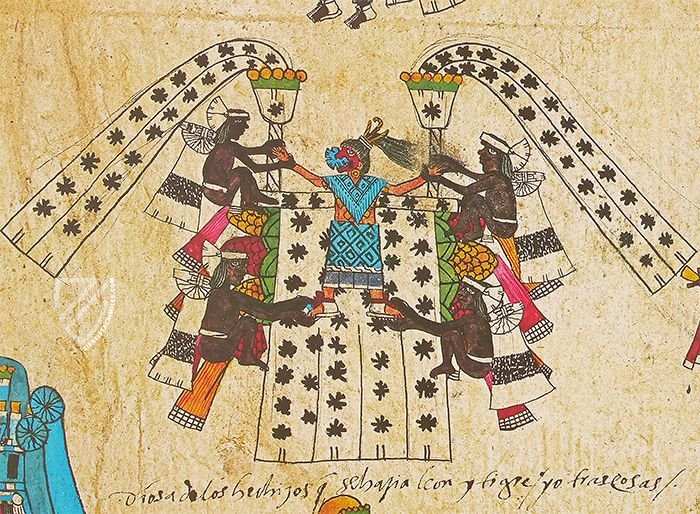
Codex Borbonicus
The 13th Trecena
The 260-day year of the Aztec calendar was divided into 20 trecena, a 13-day period. The 13th trecena was under the auspices of the goddess Tlazōlteōtl, a deity of vice, purification, steam baths, lust, filth, and a patroness of adulterers who is shown on the upper left wearing a flayed skin and giving birth to Centeōtl, the male maize deity and one of the most important figures of the Aztec religion.
By both encouraging sin and presiding over purification, Tlazōlteōtl played an important role in the confession of wrongdoing through her priests. The 13 day-signs of this trecena, starting with 1 Earthquake, 2 Flint/Knife, 3 Rain, etc., are shown on the bottom row and the column along the right side with explanatory glosses in Spanish.
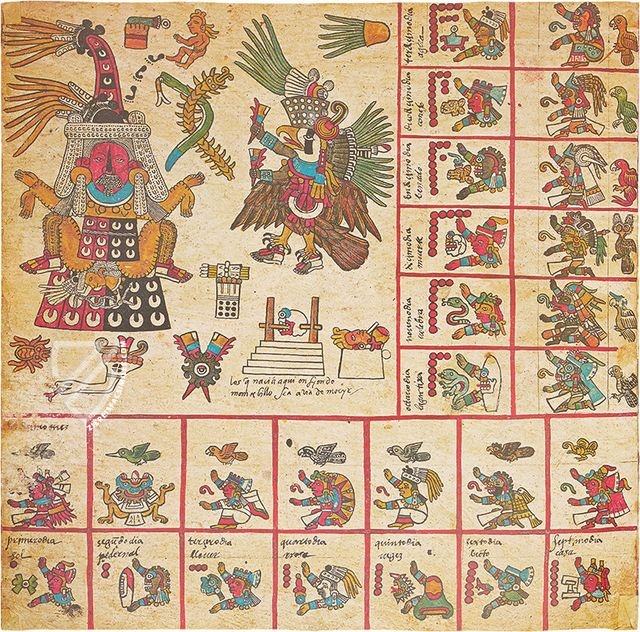
#1 Codex Borbonicus
Languages: English, French, Spanish
K. A. Nowotny, Cologne (in German); codicological description by J. de Durand-Forest, Paris (in French); summaries in English, French and Spanish. 40 pp.
(1,000€ - 3,000€)
- Treatises / Secular Books
- Apocalypses / Beatus
- Astronomy / Astrology
- Bestiaries
- Bibles / Gospels
- Chronicles / History / Law
- Geography / Maps
- Saints' Lives
- Islam / Oriental
- Judaism / Hebrew
- Single Leaf Collections
- Leonardo da Vinci
- Literature / Poetry
- Liturgical Manuscripts
- Medicine / Botany / Alchemy
- Music
- Mythology / Prophecies
- Psalters
- Other Religious Books
- Games / Hunting
- Private Devotion Books
- Other Genres
- Afghanistan
- Armenia
- Austria
- Belgium
- Belize
- Bosnia and Herzegovina
- China
- Colombia
- Costa Rica
- Croatia
- Cyprus
- Czech Republic
- Denmark
- Egypt
- El Salvador
- Ethiopia
- France
- Germany
- Greece
- Guatemala
- Honduras
- Hungary
- India
- Iran
- Iraq
- Israel
- Italy
- Japan
- Jordan
- Kazakhstan
- Kyrgyzstan
- Lebanon
- Liechtenstein
- Luxembourg
- Mexico
- Morocco
- Netherlands
- Palestine
- Panama
- Peru
- Poland
- Portugal
- Romania
- Russia
- Serbia
- Spain
- Sri Lanka
- Sweden
- Switzerland
- Syria
- Tajikistan
- Turkey
- Turkmenistan
- Ukraine
- United Kingdom
- United States
- Uzbekistan
- Vatican City
- A. Oosthoek, van Holkema & Warendorf
- Aboca Museum
- Ajuntament de Valencia
- Akademie Verlag
- Akademische Druck- u. Verlagsanstalt (ADEVA)
- Aldo Ausilio Editore - Bottega d’Erasmo
- Alecto Historical Editions
- Alkuin Verlag
- Almqvist & Wiksell
- Amilcare Pizzi
- Andreas & Andreas Verlagsbuchhandlung
- Archa 90
- Archiv Verlag
- Archivi Edizioni
- Arnold Verlag
- ARS
- Ars Magna
- ArtCodex
- AyN Ediciones
- Azimuth Editions
- Badenia Verlag
- Bärenreiter-Verlag
- Belser Verlag
- Belser Verlag / WK Wertkontor
- Benziger Verlag
- Bernardinum Wydawnictwo
- BiblioGemma
- Biblioteca Apostolica Vaticana (Vaticanstadt, Vaticanstadt)
- Bibliotheca Palatina Faksimile Verlag
- Bibliotheca Rara
- Boydell & Brewer
- Bramante Edizioni
- Bredius Genootschap
- Brepols Publishers
- British Library
- C. Weckesser
- Caixa Catalunya
- Canesi
- CAPSA, Ars Scriptoria
- Caratzas Brothers, Publishers
- Carus Verlag
- Casamassima Libri
- Centrum Cartographie Verlag GmbH
- Chavane Verlag
- Christian Brandstätter Verlag
- Circulo Cientifico
- Club Bibliófilo Versol
- Club du Livre
- CM Editores
- Collegium Graphicum
- Collezione Apocrifa Da Vinci
- Comissão Nacional para as Comemorações dos Descobrimentos Portugueses
- Coron Verlag
- Corvina
- CTHS
- D. S. Brewer
- Damon
- De Agostini/UTET
- De Nederlandsche Boekhandel
- De Schutter
- Deuschle & Stemmle
- Deutscher Verlag für Kunstwissenschaft
- DIAMM
- Droz
- E. Schreiber Graphische Kunstanstalten
- Ediciones Boreal
- Ediciones Grial
- Ediclube
- Edições Inapa
- Edilan
- Editalia
- Edition Deuschle
- Edition Georg Popp
- Edition Leipzig
- Edition Libri Illustri
- Editiones Reales Sitios S. L.
- Éditions de l'Oiseau Lyre
- Editions Medicina Rara
- Editorial Casariego
- Editorial Mintzoa
- Editrice Antenore
- Editrice Velar
- Edizioni Edison
- Egeria, S.L.
- Eikon Editores
- Electa
- Emery Walker Limited
- Enciclopèdia Catalana
- Eos-Verlag
- Ephesus Publishing
- Ernst Battenberg
- Eugrammia Press
- Extraordinary Editions
- Fackelverlag
- Facsimila Art & Edition
- Facsimile Editions Ltd.
- Facsimilia Art & Edition Ebert KG
- Faksimile Verlag
- Feuermann Verlag
- Folger Shakespeare Library
- Franco Cosimo Panini Editore
- Friedrich Wittig Verlag
- Fundación Hullera Vasco-Leonesa
- G. Braziller
- Gabriele Mazzotta Editore
- Gebr. Mann Verlag
- Gesellschaft für graphische Industrie
- Getty Research Institute
- Giovanni Domenico de Rossi
- Giunti Editore
- Graffiti
- Grafica European Center of Fine Arts
- Guido Pressler
- Guillermo Blazquez
- Gustav Kiepenheuer
- H. N. Abrams
- Harrassowitz
- Harvard University Press
- Helikon
- Hendrickson Publishers
- Henning Oppermann
- Herder Verlag
- Hes & De Graaf Publishers
- Hoepli
- Holbein-Verlag
- Houghton Library
- Hugo Schmidt Verlag
- Idion Verlag
- Il Bulino, edizioni d'arte
- ILte
- Imago
- Insel Verlag
- Insel-Verlag Anton Kippenberger
- Instituto de Estudios Altoaragoneses
- Instituto Nacional de Antropología e Historia
- Introligatornia Budnik Jerzy
- Istituto dell'Enciclopedia Italiana - Treccani
- Istituto Ellenico di Studi Bizantini e Postbizantini
- Istituto Geografico De Agostini
- Istituto Poligrafico e Zecca dello Stato
- Italarte Art Establishments
- Jan Thorbecke Verlag
- Johnson Reprint Corporation
- Josef Stocker
- Josef Stocker-Schmid
- Jugoslavija
- Karl W. Hiersemann
- Kasper Straube
- Kaydeda Ediciones
- Kindler Verlag / Coron Verlag
- Kodansha International Ltd.
- Konrad Kölbl Verlag
- Kurt Wolff Verlag
- La Liberia dello Stato
- La Linea Editrice
- La Meta Editore
- Lambert Schneider
- Landeskreditbank Baden-Württemberg
- Leo S. Olschki
- Les Incunables
- Liber Artis
- Library of Congress
- Libreria Musicale Italiana
- Lichtdruck
- Lito Immagine Editore
- Lumen Artis
- Lund Humphries
- M. Moleiro Editor
- Maison des Sciences de l'homme et de la société de Poitiers
- Manuscriptum
- Martinus Nijhoff
- Maruzen-Yushodo Co. Ltd.
- MASA
- Massada Publishers
- McGraw-Hill
- Metropolitan Museum of Art
- Militos
- Millennium Liber
- Müller & Schindler
- Nahar - Stavit
- Nahar and Steimatzky
- National Library of Wales
- Neri Pozza
- Nova Charta
- Oceanum Verlag
- Odeon
- Orbis Mediaevalis
- Orbis Pictus
- Österreichische Staatsdruckerei
- Oxford University Press
- Pageant Books
- Parzellers Buchverlag
- Patrimonio Ediciones
- Pattloch Verlag
- PIAF
- Pieper Verlag
- Plon-Nourrit et cie
- Poligrafiche Bolis
- Presses Universitaires de Strasbourg
- Prestel Verlag
- Princeton University Press
- Prisma Verlag
- Priuli & Verlucca, editori
- Pro Sport Verlag
- Propyläen Verlag
- Pytheas Books
- Quaternio Verlag Luzern
- Reales Sitios
- Recht-Verlag
- Reichert Verlag
- Reichsdruckerei
- Reprint Verlag
- Riehn & Reusch
- Roberto Vattori Editore
- Rosenkilde and Bagger
- Roxburghe Club
- Salerno Editrice
- Saltellus Press
- Sandoz
- Sarajevo Svjetlost
- Schöck ArtPrint Kft.
- Schulsinger Brothers
- Scolar Press
- Scrinium
- Scripta Maneant
- Scriptorium
- Shazar
- Siloé, arte y bibliofilia
- SISMEL - Edizioni del Galluzzo
- Sociedad Mexicana de Antropología
- Société des Bibliophiles & Iconophiles de Belgique
- Soncin Publishing
- Sorli Ediciones
- Stainer and Bell
- Studer
- Styria Verlag
- Sumptibus Pragopress
- Szegedi Tudomànyegyetem
- Taberna Libraria
- Tarshish Books
- Taschen
- Tempus Libri
- Testimonio Compañía Editorial
- Thames and Hudson
- The Clear Vue Publishing Partnership Limited
- The Facsimile Codex
- The Folio Society
- The Marquess of Normanby
- The Richard III and Yorkist History Trust
- Tip.Le.Co
- TouchArt
- TREC Publishing House
- TRI Publishing Co.
- Trident Editore
- Tuliba Collection
- Typis Regiae Officinae Polygraphicae
- Union Verlag Berlin
- Universidad de Granada
- University of California Press
- University of Chicago Press
- Urs Graf
- Vallecchi
- Van Wijnen
- VCH, Acta Humaniora
- VDI Verlag
- VEB Deutscher Verlag für Musik
- Verlag Anton Pustet / Andreas Verlag
- Verlag Bibliophile Drucke Josef Stocker
- Verlag der Münchner Drucke
- Verlag für Regionalgeschichte
- Verlag Styria
- Vicent Garcia Editores
- W. Turnowski Ltd.
- W. Turnowsky
- Waanders Printers
- Wiener Mechitharisten-Congregation (Wien, Österreich)
- Wissenschaftliche Buchgesellschaft
- Wissenschaftliche Verlagsgesellschaft
- Wydawnictwo Dolnoslaskie
- Xuntanza Editorial
- Zakład Narodowy
- Zollikofer AG

